Olympic triangular patterns to windward-leeward
The transformation of Performance Handicap Racing Fleet (PHRF) race courses from traditional Olympic triangular patterns to windward-leeward configurations represents a significant shift in recreational sailing competition. While the search results do not provide definitive evidence of a coordinated effort by non-planing sailboat manufacturers to drive this change, they do reveal important developments in racing formats, handicapping systems, and boat design that have collectively reshaped the competitive sailing landscape.

The creation of specialized PHRF Cruising Classes, as recently as 2022, suggests an ongoing response to address the needs of cruiser-racer owners who may have felt disadvantaged by course designs that favor specialized racing vessels.
The relationship between course design and boat performance has clearly influenced naval architecture, with designers creating vessels optimized for specific racing conditions—effectively developing “horses for courses”—though the exact timeline of this evolution remains somewhat unclear from the available evidence. For the South Sound Sailing Society the bouy courses were changed to windward leeward in 2003.
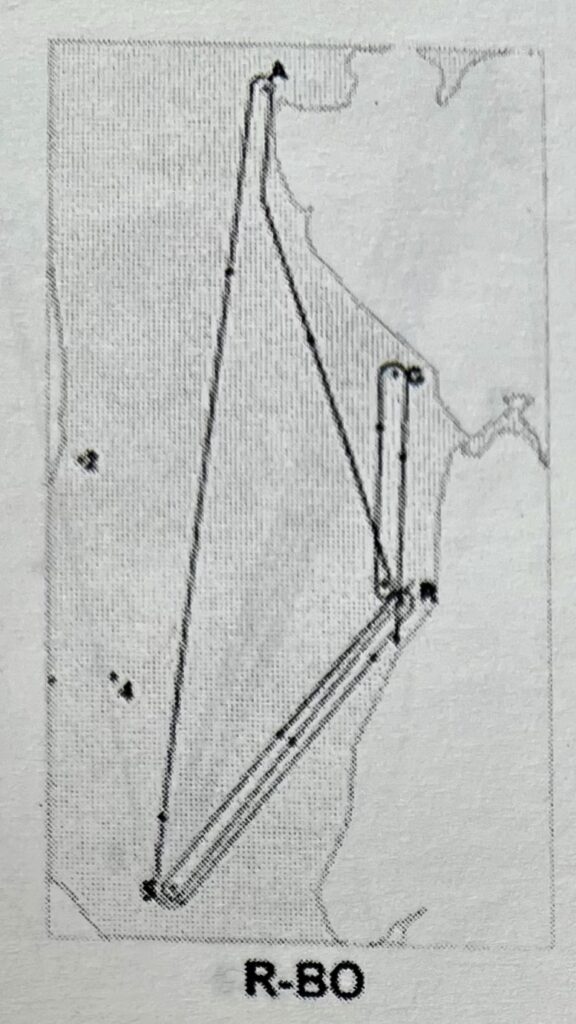
The Distinction Between Racing Course Formats
Sailing regattas employ various course configurations that test different aspects of sailing skill and boat performance. The distinction between these formats is crucial for understanding how course design can impact competitive dynamics and boat selection preferences. Traditional Olympic courses typically feature triangular patterns with reaching legs, while modern racing often emphasizes the more technical windward-leeward format.
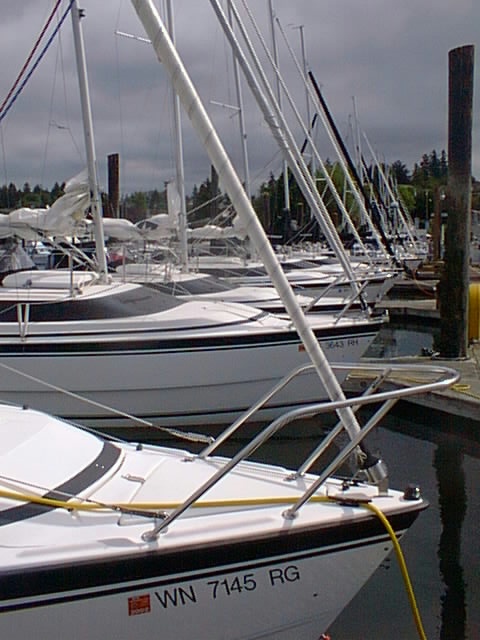
Windward-leeward courses consist of two primary legs: the upwind portion where sailors tack against the wind toward a designated windward mark, and the downwind return to a leeward mark. These courses emphasize tactical decision-making, boat speed optimization, and strategic positioning. The repeated upwind and downwind legs create opportunities for tactical maneuvers, which can advantage boats designed specifically for upwind and downwind performance rather than all-round sailing capabilities. As described in sailing literature, these courses “emphasize tactical decision-making, boat speed and strategic positioning,” creating a more technically demanding racing environment that may favor specialized racing designs over versatile cruiser-racers2.
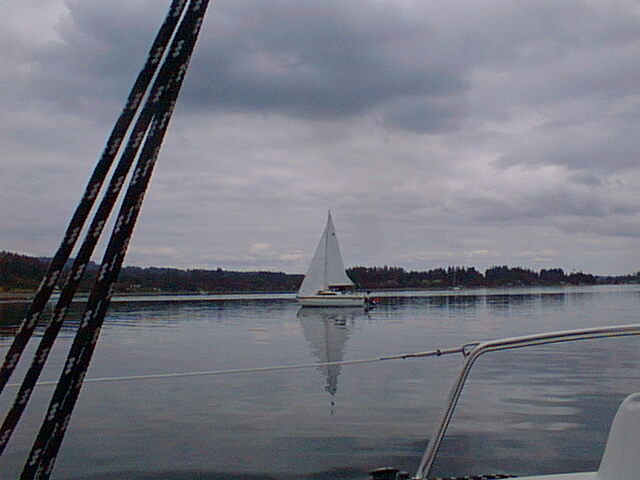
In contrast, Random Leg courses, which more closely resemble traditional Olympic-style racing with varied angles to the wind, present “a new adventure, with sailors facing ever-changing wind angles and shifting currents.” The unpredictability of these courses “adds an element of excitement to regatta racing” and requires sailors to “constantly assess wind shifts, current patterns and strategic options”2. This format generally provides more balanced competition across different boat types, as it tests a wider range of sailing capabilities rather than specialized upwind and downwind performance.
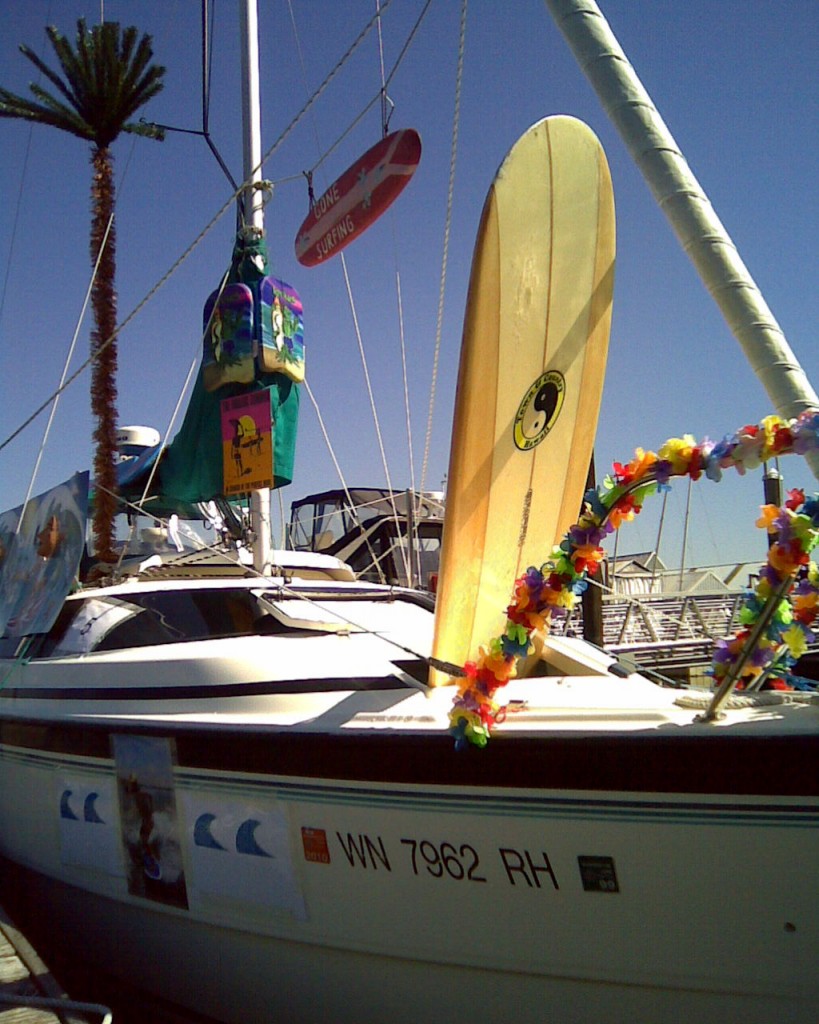
The PHRF System and Its Evolution
The Performance Handicap Racing Fleet (PHRF) handicapping system was developed with the intention of creating fair competition among diverse boat designs. PHRF is fundamentally “a performance handicap, i.e., the rating depends on how fast the owners sail a class of boats”6. This system theoretically allows different boat types to compete equitably by assigning time corrections based on established performance characteristics.

The beauty of handicapped racing, as one sailor notes, is that you can “get a boat you like and have somewhat fair racing”3. This principle suggests that “PHRF makes everyone competitive”3, which should theoretically allow cruiser-racers to compete successfully against more specialized racing designs. However, the reality has proven more complex, as course designs can significantly impact how different boats perform relative to their handicaps.
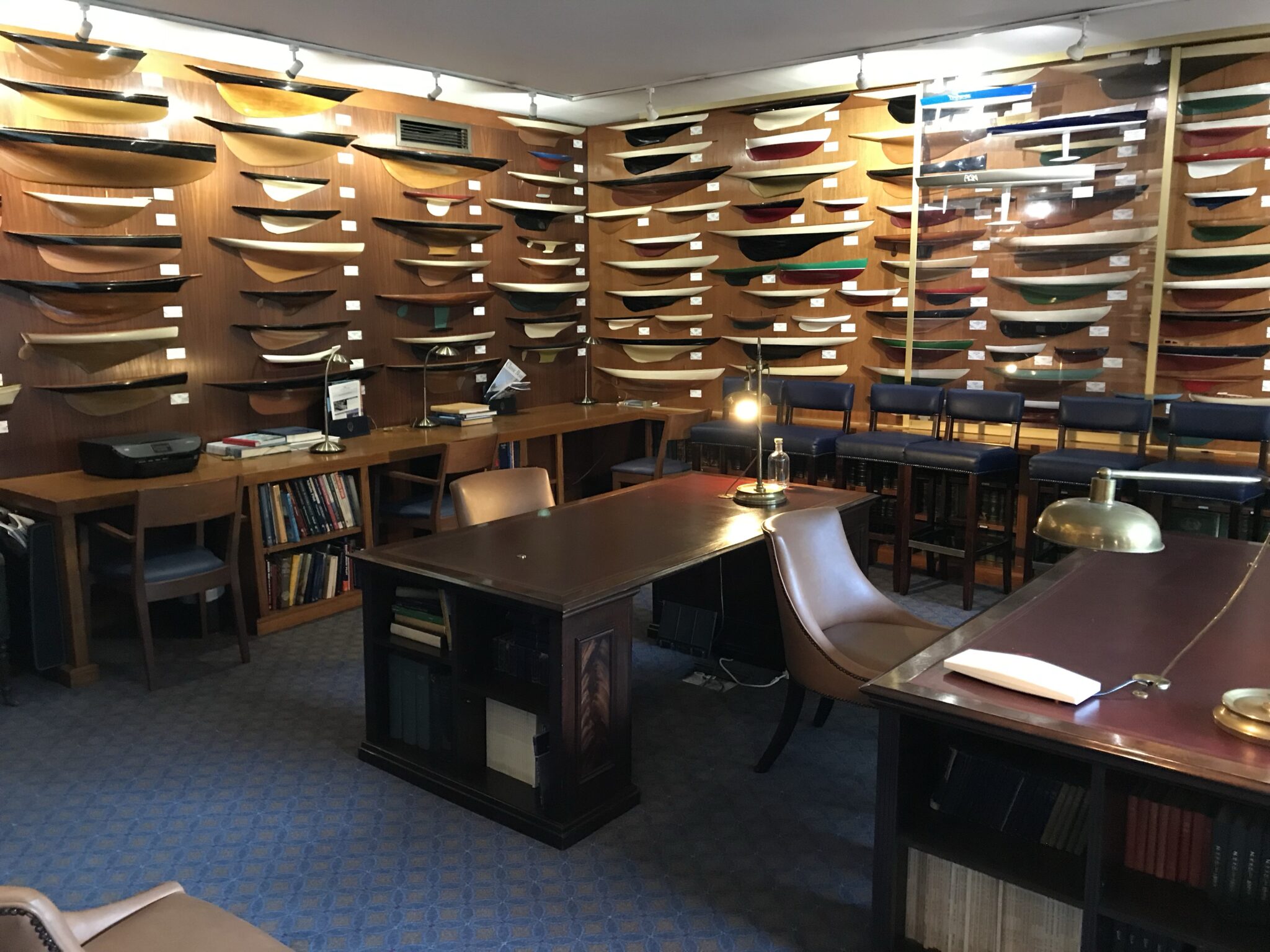
As sailing competition evolved, the PHRF system has needed to adapt to changing boat designs and racing preferences. Evidence of this adaptation can be seen in the relatively recent creation of specialized classifications. For instance, “PHRF Cruising Class is new for 2022!” and is specifically “designed for ‘true’ cruising sailboats that are not designed as modern racers or sportboats”1. This development strongly suggests that standard PHRF racing had evolved in ways that disadvantaged cruising-oriented vessels, necessitating a separate class with modified rules to ensure fair competition.
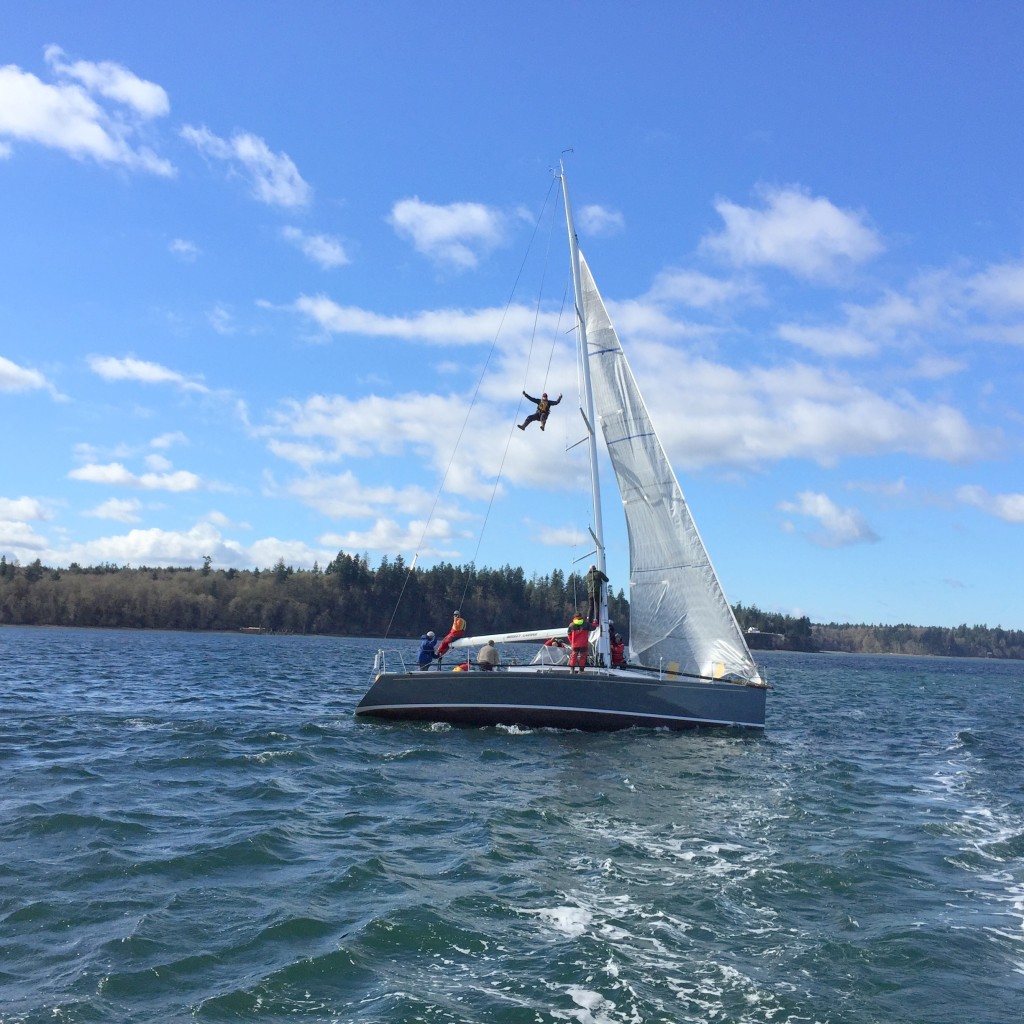
Types of Sailboats, Examples, and Definitions
1. Racer
- Definition: Sailboats designed for speed and competitive sailing, with lightweight construction and minimal onboard amenities.
- Examples:
- J/105: PHRF ~904.
- Melges 24: PHRF ~99.
- Farr 40: PHRF ~9.
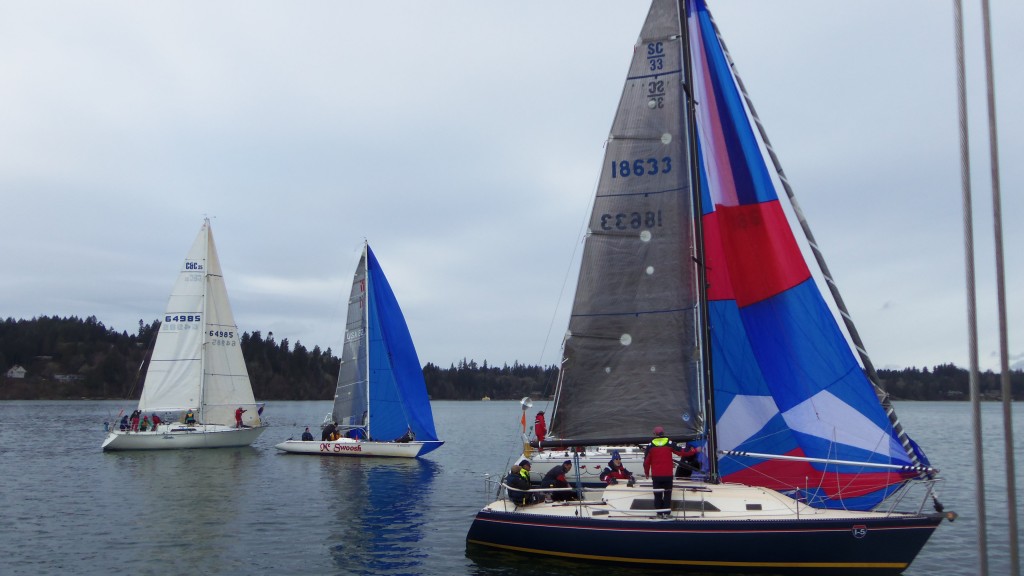
2. Cruiser
- Definition: Built for comfort and long-distance sailing, with spacious cabins and amenities for extended voyages.
- Examples:

3. Cruiser-Racer / Racer-Cruiser
- Definition: A hybrid combining racing performance with cruising comfort, offering competitive speed and moderate amenities.
- Examples:
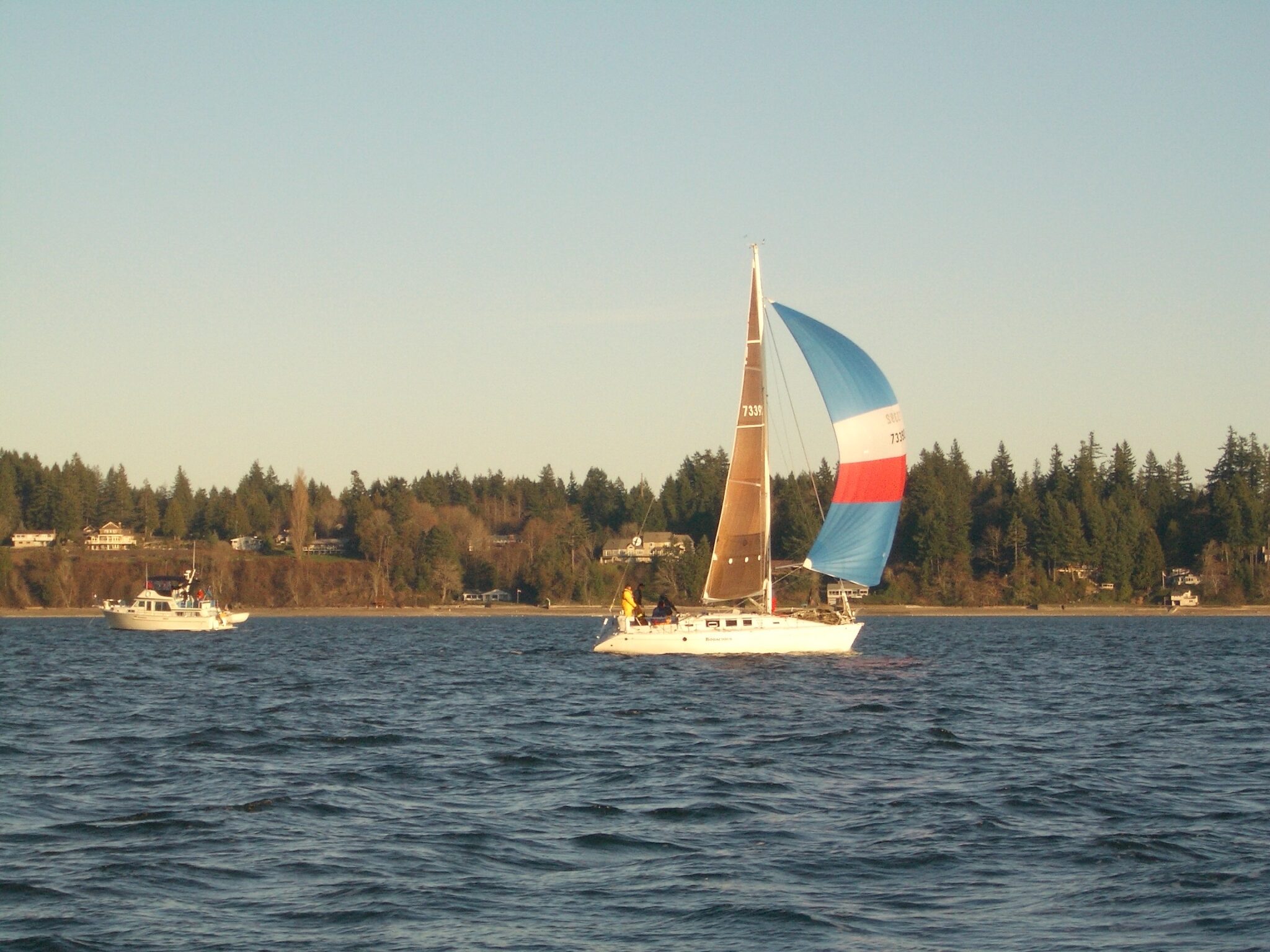
4. Performance Cruiser
- Definition: Focuses on cruising comfort but includes features for enhanced speed and handling.
- Examples:
- Hanse 418: PHRF ~90.
- X-Yachts X4.6: PHRF ~60.
- Oyster 565: No specific PHRF available.

5. Sport Boat
- Definition: Lightweight, high-performance sailboats designed for agility and speed in short-course racing (“round-the-cans”).
Characteristics:- Displacement-to-length ratio ≤105.
- Sail area-to-displacement ratio >30 (upwind) and >65 (downwind).
- Typically trailerable and highly responsive (tender).
- Examples:
- Melges 20: PHRF ~120.
- VX One: PHRF ~117.
- Flying Tiger 10M: PHRF ~541.
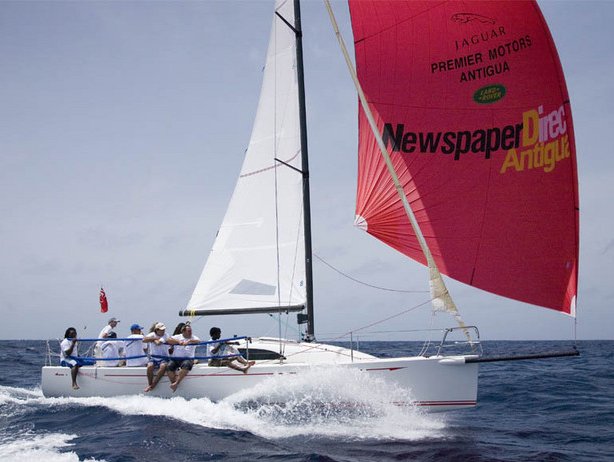
6. Motorsailer
- Definition: Combines sail power with a motor for versatility; heavier construction often limits sailing performance.
- Examples:
- Island Packet Motorsailer: No specific PHRF available.
- Nauticat 44: PHRF ~150.
7. Power-Sailer
- Definition: A hybrid vessel designed to function as both a sailboat and a powerboat. Equipped with large outboard motors for high-speed motoring and water ballast systems for stability under sail.
- Examples include the MacGregor series (e.g., MacGregor 26X, MacGregor 26M).
MacGregor Boats Classification
MacGregor 26X
- Marketed as a “power-sailer,” the MacGregor 26X combines water ballast for stability with an outboard engine enabling speeds up to 25 mph under power9. It features a fractional sloop rig but is not optimized for racing. The manufacturer claims up to 17 mph under sail.
- Classified as a Power-Sailer due to its dual-purpose design, blending motoring capabilities with sailing performance.
MacGregor 26M
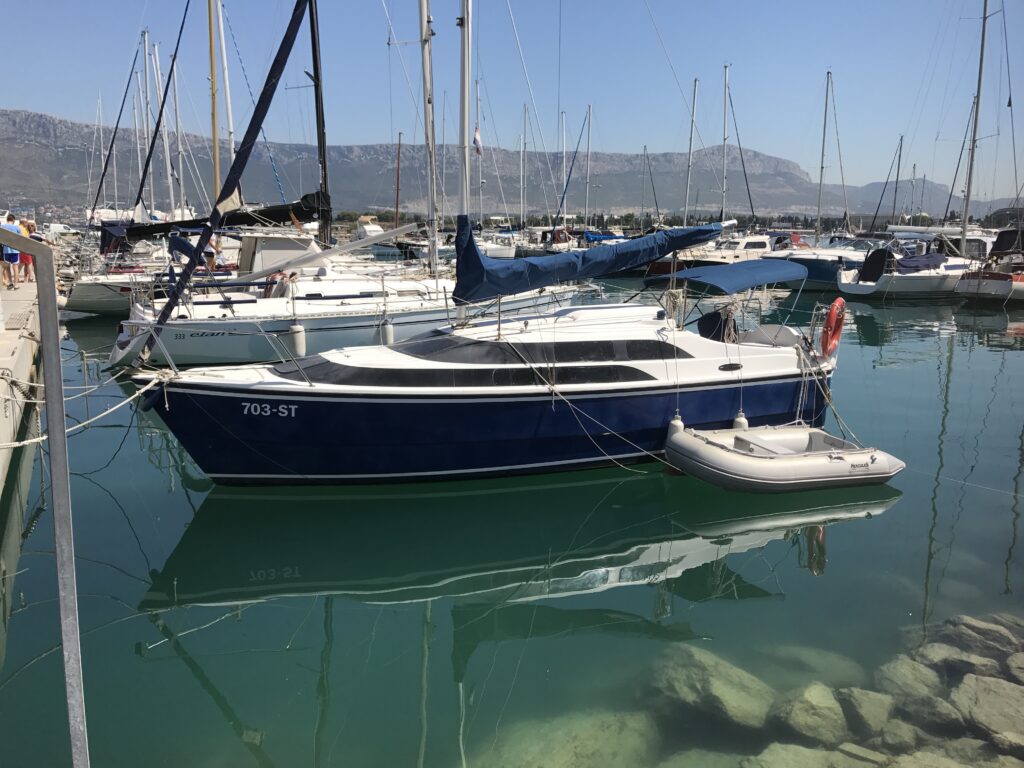
- The MacGregor 26M retains the power-sailer concept but shifts focus toward cruising comfort. It features a daggerboard instead of a centerboard, a rotating mast for improved sailing efficiency, and reduced emphasis on speed under sail compared to the 26X69. The model is not intended to sail without a full water ballast tank.
- Classified as a Power-Sailer, like the MacGregor 26X, but marketed more as a cruiser than a racer.
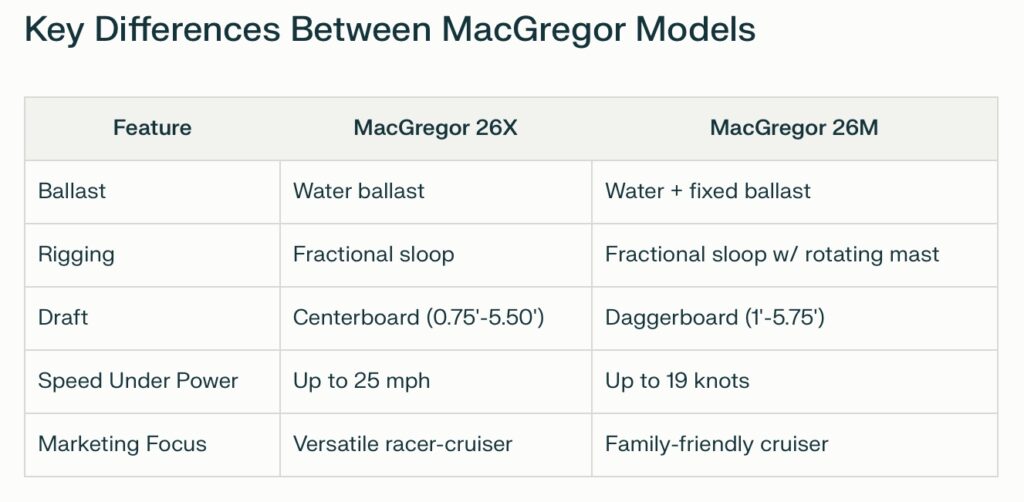
Key Differences Between MacGregor Models
FeatureMacGregor 26XMacGregor 26MBallastWater ballastWater + fixed ballastRiggingFractional sloopFractional sloop w/ rotating mastDraftCenterboard (0.75′-5.50′)Daggerboard (1′-5.75′)Speed Under PowerUp to 25 mphUp to 19 knotsMarketing FocusVersatile racer-cruiserFamily-friendly cruiser
Conclusion
Both the MacGregor 26X and MacGregor 26M are classified as Power-Sailers. While the MacGregor 26X leans slightly toward racer-cruiser functionality due to its higher motoring speeds and versatile design, the MacGregor 26M is more focused on cruising comfort and family use, making it less aligned with racing purposes. Neither model fits the definition of a sport boat due to their heavier displacement-to-length ratios.
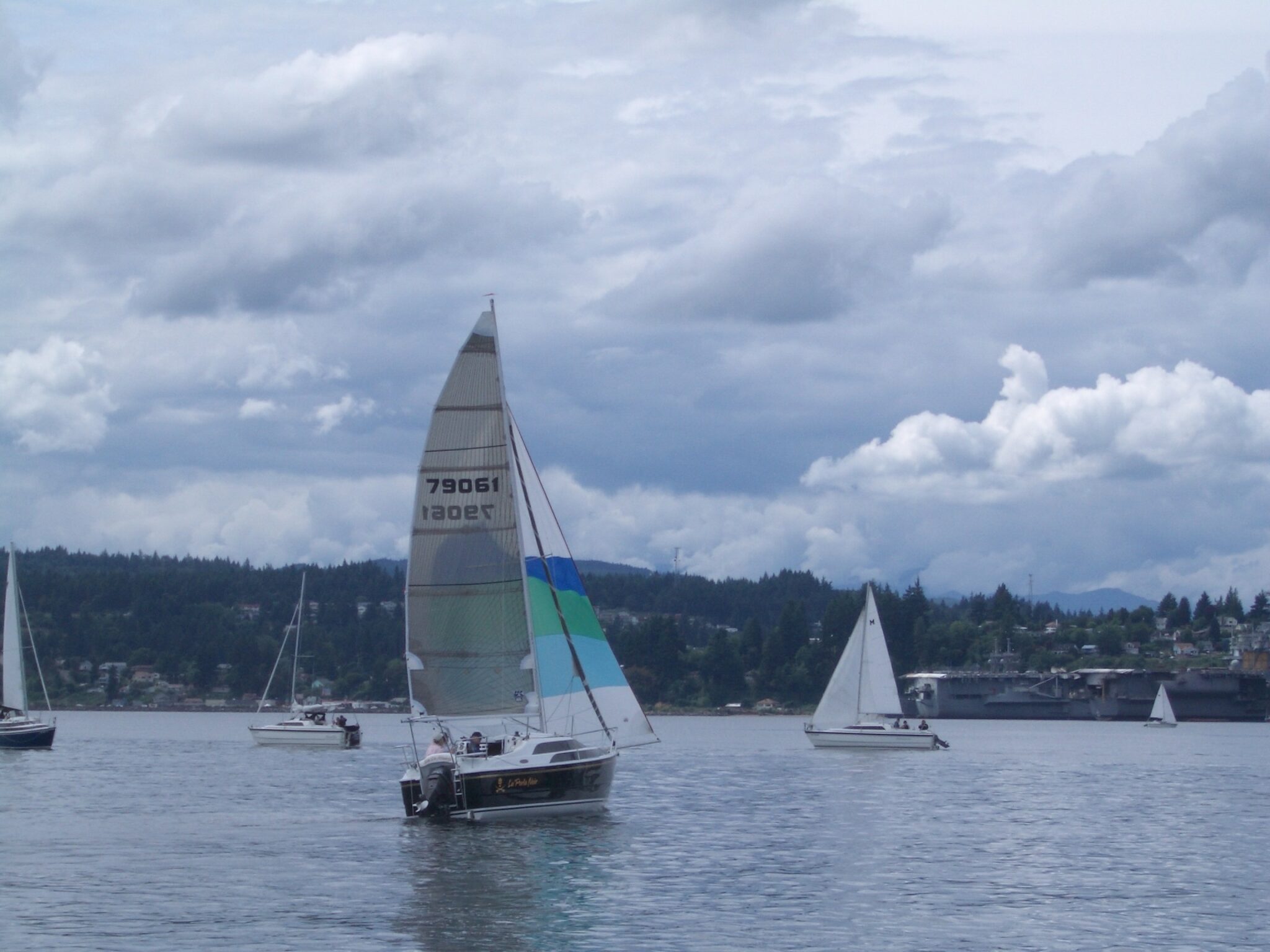
Course Design and Its Impact on Sailboat Popularity
The shift toward windward-leeward courses appears to have influenced the popularity of different boat types within the PHRF racing community. While the search results don’t explicitly document when this shift occurred, they do provide evidence of its effects. The creation of the PHRF Cruising Class in 2022 represents a significant acknowledgment that traditional cruiser-racers had become less competitive in standard PHRF racing formats1.

The specialized PHRF Cruising Class includes specific rules that establish “requirements for cruising yachts to race with family and friends, with the intended benefit of eliminating the potentially high annual investment present in the unlimited racing classes”1. This statement implicitly acknowledges that regular PHRF racing had evolved to favor more specialized and expensive racing boats, potentially disadvantaging cruiser-racers and pushing some sailors away from competitive racing.
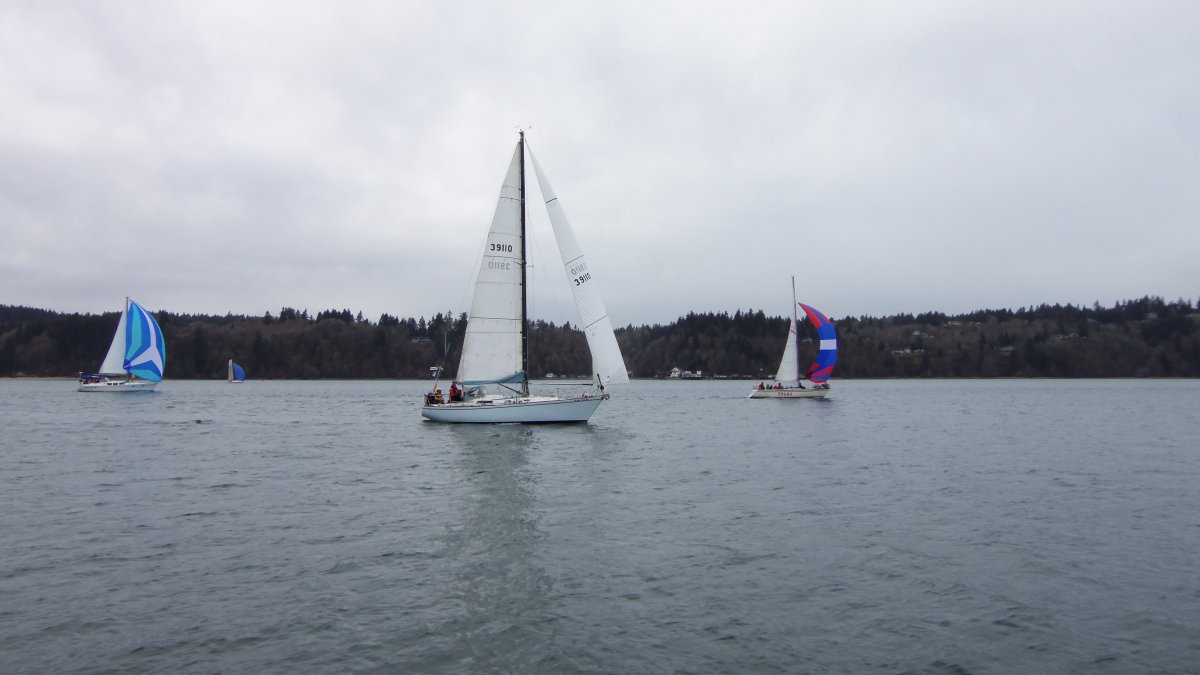
Forum discussions among sailors reflect this tension, with one sailor advising another that when choosing between racing performance and cruising comfort, they should “get something that your wife is comfortable/happy sailing. This should be your top priority”3. This advice suggests an acknowledgment that pure racing performance often comes at the expense of cruising comfort, requiring sailors to make difficult compromises based on their priorities. Consider the following:
Tony Re of South Sound Sailing Society and Olympia Yacht Club campaigned a Hunter 40 in 2002 that was over 15 years old. The interior of the vessel was decked out with wood trim and attractive upholstery. His wife was thrilled with the purchase. He wanted to race. They named the boat RE-TREAT.
RE-TREAT’s Performance Compared to Other Boats in Its Class
In 2002, RE-TREAT, a 1985 Hunter 40, demonstrated exceptional racing performance that set it apart from other boats in its class during the Swiftsure Cape Flattery Race. RE-TREAT’s performance in the Swiftsure Cape Flattery Race was remarkable by any standard:
- It achieved first place in its division
- It won first place in its class
- It claimed first place overall in the competition1
This triple achievement is particularly impressive considering the scale and difficulty of the race. The Swiftsure is described as “one of the top US regattas” and “the biggest in the Northwest US.” The 2002 race featured approximately 196 competing boats, of which only about 40 (roughly 20%) completed the challenging 100+ nautical mile course1.
Hunter 40 as a Platform
The Hunter Legend 40 (also known as Hunter 40-1) is generally categorized as a “performance cruiser” rather than a dedicated racing boat2. RE-TREAT’s modifications for Swiftsure involved winches and several sets of sails including a drifter Genoa that could be deployed on a tuff luff track prior to dropping the head sail (called pealing) and multiple spinnakers. The Hunter 40 platform is described as:
Owner’s Perspective
According to owner Tony Re, “Hunters are one of the fastest cruising boats out there..(with the right crew and sails)”1.This suggests that while the Hunter 40 may not be specifically designed as a racing vessel, it has strong performance potential when properly equipped and crewed.
Crew Factor
RE-TREAT’s success can be attributed partly to its “outstanding crew of 11”1. This suggests that proper crew management and tactical decisions were significant factors in its competitive advantage.
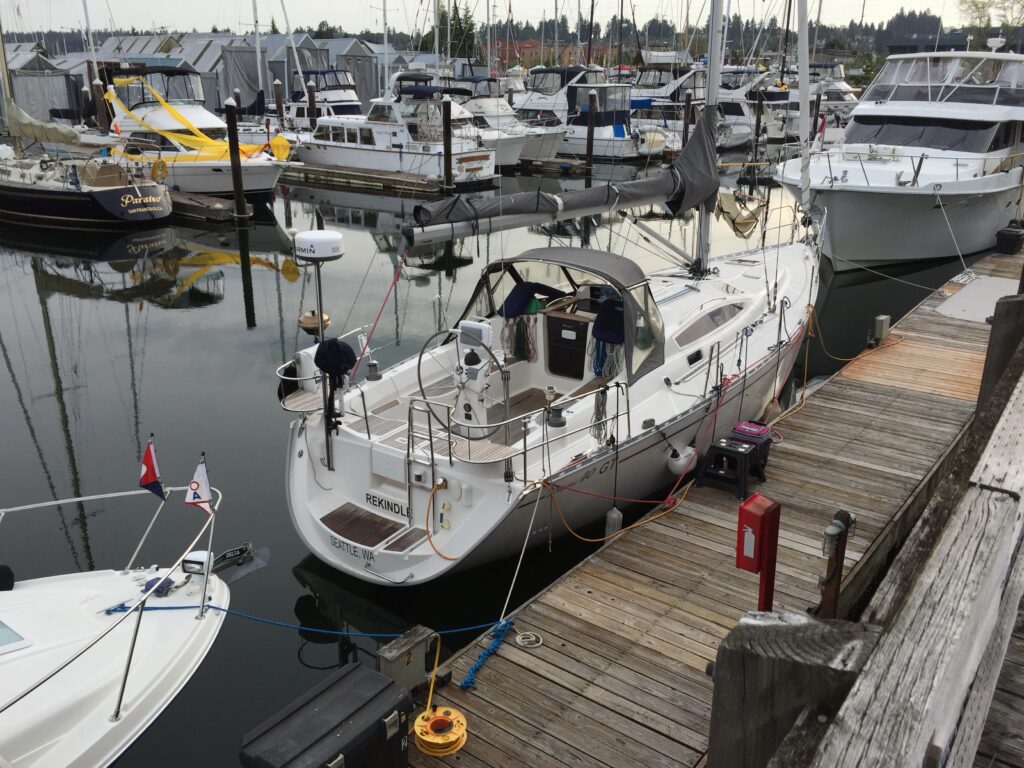
When the Hunter 40 heels, its effective waterline length grows, enabling it to achieve speeds closer to its theoretical hull speed of 7.64 knots.
Recognition Issues
Despite its impressive performance, Tony Re noted that race officials and local newspapers focused attention on “other EXPENSIVE boats” rather than acknowledging RE-TREAT’s victory1. This could indicate that RE-TREAT’s performance exceeded expectations for boats of its type and price point, perhaps outperforming more expensive purpose-built racing vessels.
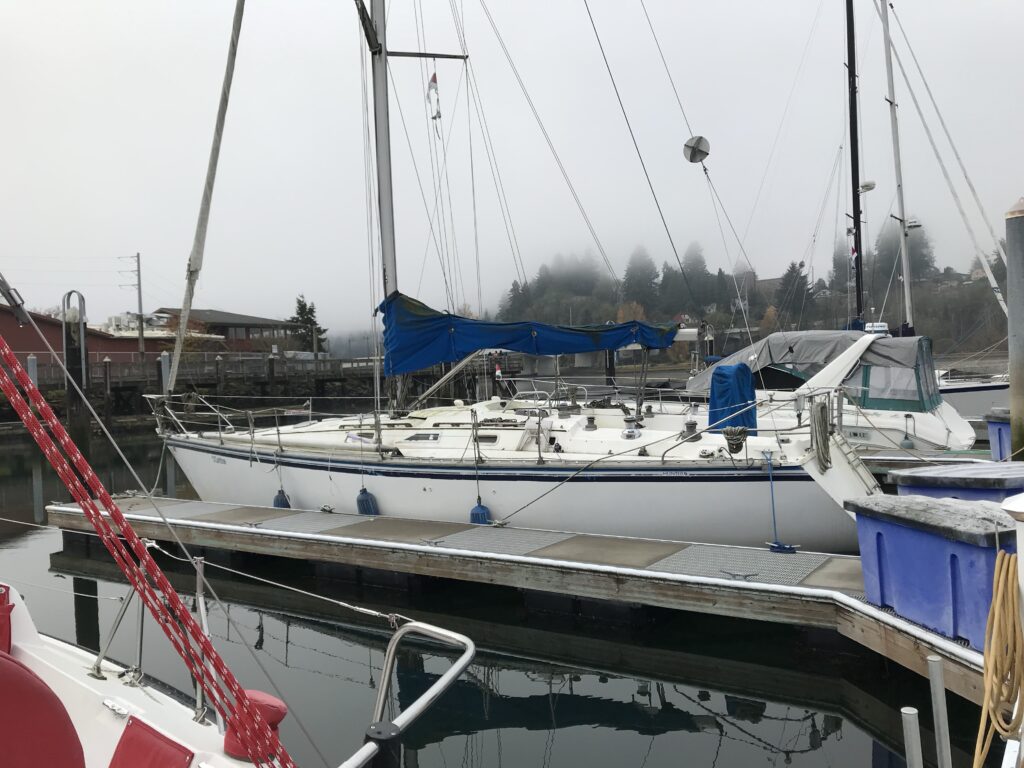
The Hunter company was thrilled about the win and wanted to use the accomplishment in testimonials to sell sailboats but Tony refused because he believed much of the win could be attributed to modifications he had made for the priority of racing. The vessel was later used as a family cruising boat and then sold to Terry Anderson.
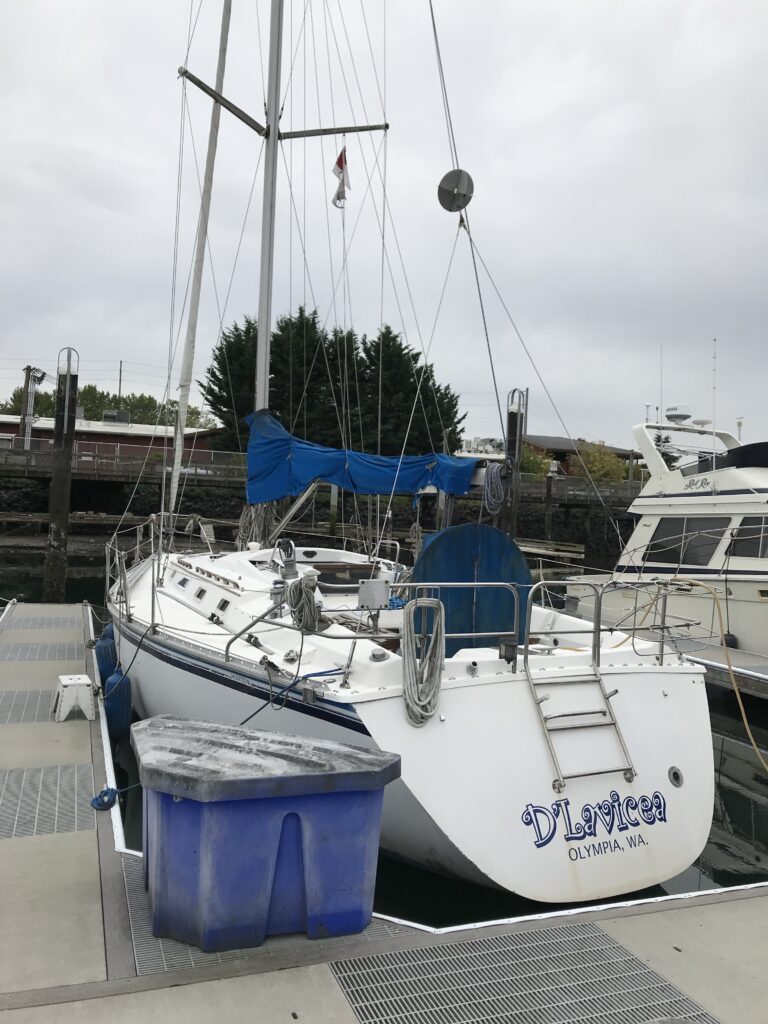
Terry was enticed by the racing history of his Hunter 40 but was rarely able to get the boat to perform at the level of its PHRF rating. The boat required fast spinnaker deployment to do well. Perhaps more than a few sailboats sold as performance cruisers are the same way.

Naval Architecture Responses to Racing Formats
The search results provide compelling evidence that naval architects design boats with specific sailing conditions and race formats in mind, essentially creating “horses for courses.” One example discusses how a sailboat designed for “predominantly light winds under 10 knots true” with “short steep chop” would have different characteristics than one designed for areas “where the winds were typically 15 knots and above”6. The former might have a higher sail area/displacement ratio (24 versus 19), more sail area (702 sq. ft. versus 580 sq. ft.), and deeper draft (6’10” versus 4’11”)6.
These design decisions directly impact a boat’s PHRF rating and its performance on different course types. The technical specifications clearly demonstrate how naval architects optimize designs for anticipated conditions and intended use. A boat designed for light air performance with a high sail area/displacement ratio would likely perform differently on windward-leeward courses compared to Olympic-style courses with reaching legs.
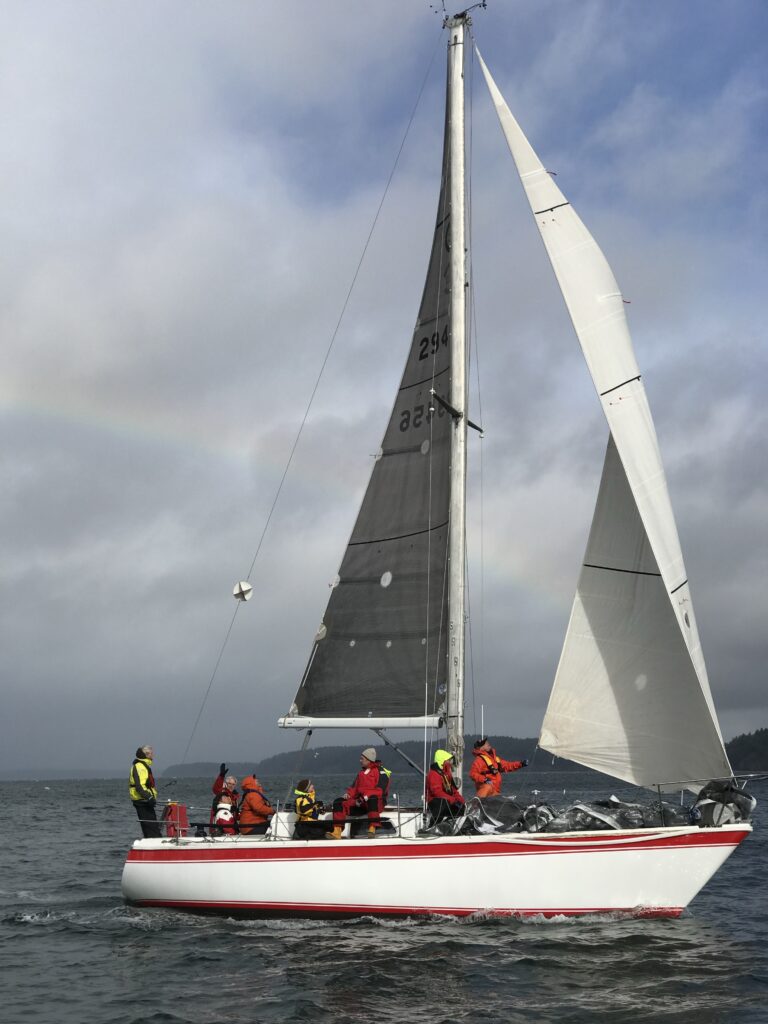
The discussion of boat design suggests that as racing courses changed, boat designs likely evolved in response. Modern racing-oriented designs may have increasingly optimized for windward-leeward performance at the expense of reaching performance, potentially creating a feedback loop where course designs and boat designs reinforced each other, gradually moving away from characteristics valued by cruiser-racer owners.
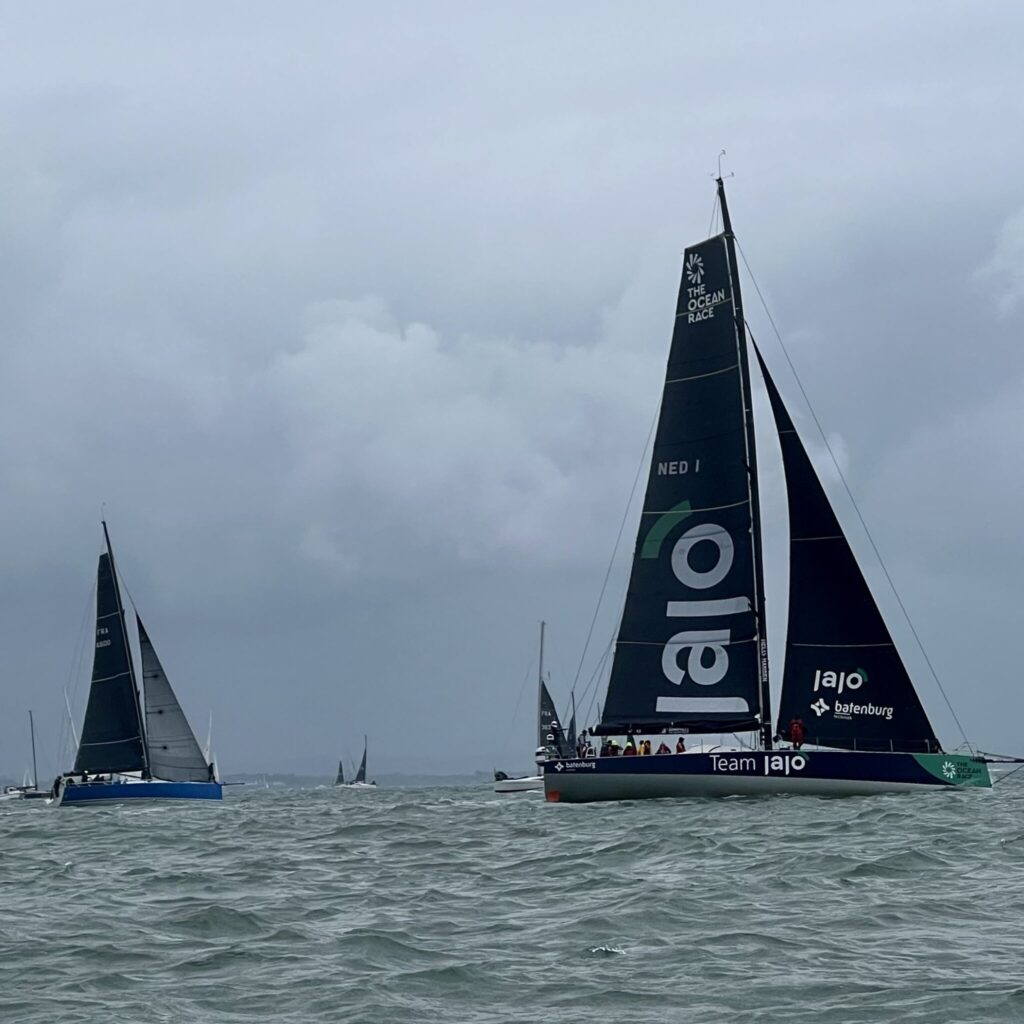
The Impact of Racing Tradition and Course Changes
Sailing communities often place significant value on tradition and history, which can make changes to established race formats controversial. The example of the Rolex Fastnet Race illustrates this dynamic clearly. When organizers changed the finish location from Plymouth, UK to Cherbourg, France, it generated controversy despite the alleged aim of permitting more participation. Critics argued this showed “a complete disdain for history,” noting that the traditional course “was a measure of boat and sailor, with tragedy and triumph recorded along that 600nm course”5.

This example demonstrates how changes to race courses can be perceived as undermining sailing traditions. In the PHRF context, the shift from Olympic-style courses to windward-leeward formats might similarly have been viewed by some sailors as discounting the value of all-round sailing ability in favor of specialized upwind and downwind performance. Such perceptions could contribute to cruiser-racer owners feeling that modern PHRF racing no longer reflects their values or sailing priorities.
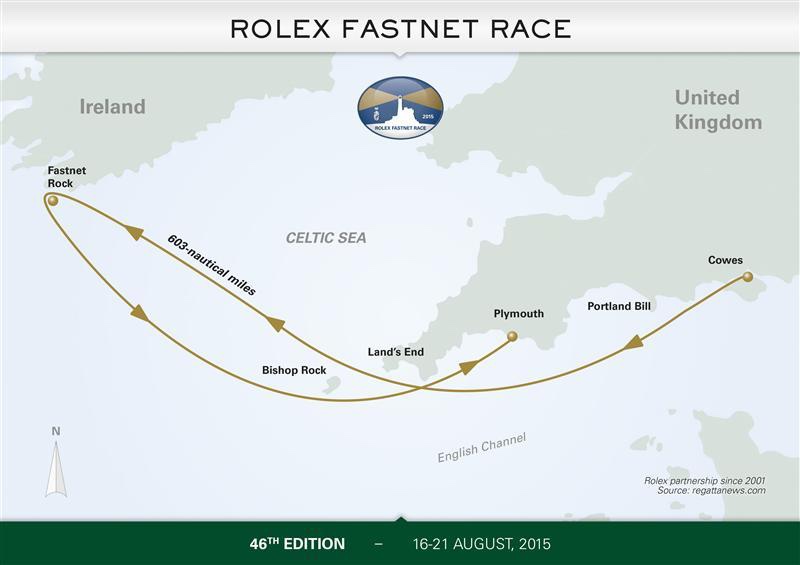
The sailing community’s response to course changes is further illustrated by the World Sailing Speed Record Council’s decision to ratify a speed record specifically for the “Original Fastnet Course,” emphasizing the continued significance of traditional race formats even as new ones emerge5. This suggests that even as racing evolves, there remains a constituency of sailors who value historical continuity and traditional approaches to competition.
Contemporary Adaptations in PHRF Racing
Recent developments in PHRF racing suggest an acknowledgment of the need to accommodate various boat types and sailor preferences. The creation of specialized cruising classes represents an attempt to address concerns from cruiser-racer owners who may have felt disadvantaged by contemporary race formats and fleet compositions.
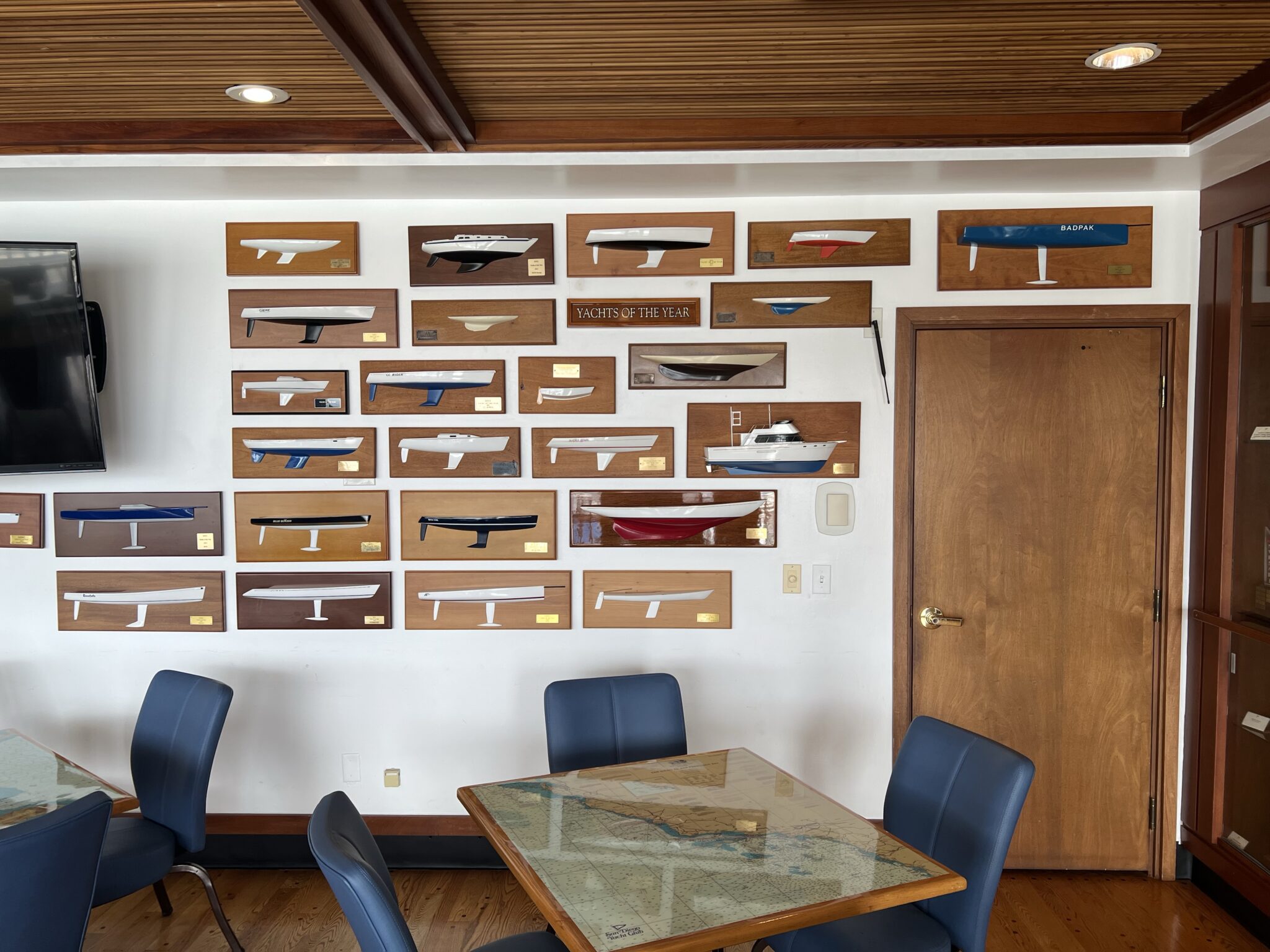
The PHRF Cruising Class established in 2022 includes specific limitations on boats and equipment to ensure fair competition among true cruising vessels. For instance, boats must comply with certain sail area to displacement ratios and sail material construction requirements that are not imposed on regular PHRF racers1. This differentiation implicitly acknowledges that standard PHRF racing had evolved in ways that disadvantaged cruising-oriented designs.
The rules specify that “A Yacht with a Cruising Class certificate can race under that certificate in a regular PHRF Class. However a Yacht with a regular PHRF certificate cannot race under that certificate in a Cruising Class”1. This one-way compatibility underscores the intention to create a protected space for cruiser-racers while still allowing them to participate in broader competition if desired.
These adaptations represent ongoing efforts to maintain PHRF racing’s appeal across diverse segments of the sailing community. By creating specialized classifications and rules, organizers attempt to accommodate both specialized racing designs and more versatile cruiser-racers, potentially addressing some of the concerns that led to PHRF losing favor among certain boat owners.
Conclusion
The evolution of PHRF race courses from Olympic-style to windward-leeward formats represents a significant shift in competitive sailing that has impacted boat design, sailor preferences, and competitive dynamics. While the available evidence doesn’t definitively establish a coordinated effort by non-planing sailboat manufacturers to drive this change, it does reveal a complex interplay between course design, boat performance, and sailing community preferences.
The creation of specialized cruising classes within the PHRF system suggests an acknowledgment that modern racing formats may have disadvantaged traditional cruiser-racers, potentially contributing to PHRF losing favor among some boat owners. Naval architects clearly design vessels optimized for specific conditions and purposes, supporting the notion that course designs influence boat design in a “horses for courses” dynamic.
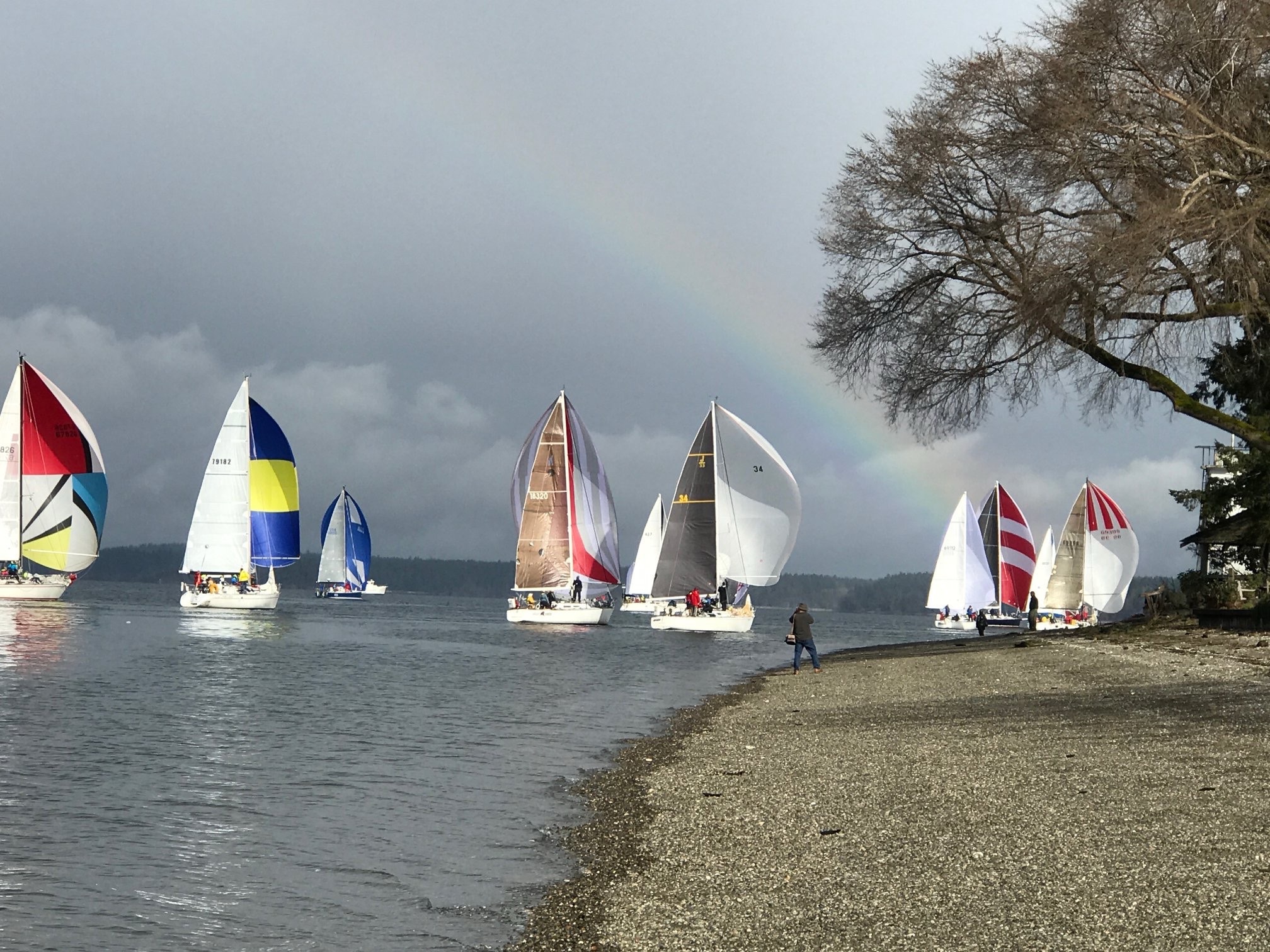
As the sailing community continues to evolve, finding balance between specialized racing performance and broader accessibility remains a challenge. Recent adaptations like the PHRF Cruising Class represent attempts to accommodate diverse preferences while maintaining competitive integrity. The ongoing dialogue between tradition and innovation in sailing course design, handicapping systems, and boat development will likely continue to shape the future of recreational sailing competition.
Citations:
- http://www.phrfchesbay.org/page/rules/cruising
- https://thelog.com/deciphering-regatta-courses-understanding-random-leg-and-windward-leeward-racing/
- https://www.reddit.com/r/sailing/comments/14x2hv4/talk_me_out_of_a_compromise_cruiserracer/
- https://onezootree.co.za/careers-with-animals/dream-career-according-to-interests-or-talents/career-with-animals-using-art-and-design-talents/career-as-a-horse-course-designer/
- https://www.sailingscuttlebutt.com/2021/04/14/when-you-change-history-you-cant-forget-it/
- https://forums.sailboatowners.com/threads/phrf-rating-adjustments.166377/
- https://clsa.clubexpress.com/content.aspx?page_id=22&club_id=294469&module_id=242763
- http://www.phrfchesbay.org/page/organization/fleet_policies
- https://www.strath.ac.uk/courses/undergraduate/navalarchitecturewithhighperformancemarinevehiclesbeng/
- https://www.sailingworld.com/how-to/six-go-fast-tips-for-phrf/
- https://www.sailingworld.com/racing/bring-back-the-reach/
- https://forums.sailinganarchy.com/threads/the-problem-with-phrf.3860/
- http://www.sailjax.com/FCSA-PHRF-Rules.pdf
- https://www.regattanetwork.com/clubmgmt/regatta_uploads/22014/2021_Commodores_Cup_SI_Appendix_A4.5.21.pdf
- https://www.morganscloud.com/2024/07/05/converting-a-racing-sailboat-to-a-fast-cruiser-performance-and-rig/
- https://en.wikipedia.org/wiki/Performance_Handicap_Racing_Fleet
- https://forums.ybw.com/threads/windward-leeward-vs-olympic.437178/
- https://forums.sailboatowners.com/threads/significance-of-phrf-ratings.71836/
- https://www.yachtsandyachting.com/Forum/forum_posts.asp?TID=8135&PID=1302687&title=windward-leeward-courses-are-they-fair
- http://ri.diva-portal.org/smash/person.jsf?pid=authority-person%3A104349
- https://www.sailingscuttlebutt.com/2021/11/07/brouhaha-over-ocean-race-course-change/
- https://phrfsocal.org/wp-content/uploads/Rules/lr.pdf
- https://gh2.com/equine/
- https://www.sail-world.com/news/282720/Change-of-course-adds-tactical-twist
- https://forums.sailboatowners.com/threads/phrf-spin-vs-non-spin-adjustment.183111/
- https://phrf-lo.org/index.php/handicapping/races-analysis/58-club-race-results/489-race-course-synopsis
- https://forums.sailinganarchy.com/threads/phrf-for-cruisers.55555/
- https://westlawn.edu
- https://www.12meteryachtcharters.com/history-of-americas-cup-races
- https://www.spinsheet.com/phrf-racing-guide-part-1
- https://forum.viper640.org/viper-discussions/the-summer-of-phrf/
- https://www.ussailing.org/wp-content/uploads/2018/01/USPHRF-Fleets.pdf
- https://forums.sailinganarchy.com/threads/phrf-adjustments.67186/
- https://www.sname.org/professional-development
- https://forums.sailinganarchy.com/threads/phrf-northwest-time-on-time-scoring.101997/post-2670393
- https://www.ussailing.org/wp-content/uploads/2018/01/Starting-a-PHRF.pdf
- http://osyc.net/racing/RRS/RRS-5.html
- https://www.quantumsails.com/en/resources-and-expertise/articles/how-racing-rating-rules-work-and-how-to-maximize
- https://communities.sname.org/studentsteeringcommittee/career–award-center/career/continuing-education-for-the-maritime-professional
- https://www.sailingcatamarans.com/index.php/articles/40-general-racing-articles-technical/43-performance-multihulls-part-2
- https://canadiangeographic.ca/articles/canadas-f1-yacht-team-take-a-different-tack/
- https://forums.sailboatowners.com/threads/phrf-ratings.181175/page-2
- https://forums.sailinganarchy.com/threads/love-olympic-triangular-courses.199795/
- http://www.phrfchesbay.org/page/news/17209
- https://people.orie.cornell.edu/shane/pubs/AmCup.pdf
- https://ecsa.net/wp-content/uploads/2022/03/ECSA-PHRF-Regulations-2022-FINAL.pdf
- https://forums.sailinganarchy.com/threads/irc-versus-orc.166134/
- https://www.nytimes.com/1964/02/28/archives/course-for-americas-cup-races-changed-olympic-route-puts-heavy.html
- https://newyorksailing.club/tag/racing/
- https://en.wikipedia.org/wiki/Sailing_(sport)
- https://forums.sailinganarchy.com/threads/windward-leeward-or-triangles-for-beer-can-races.3454/
- https://www.yachtingmonthly.com/cruising-life/1979-fastnet-race-the-race-the-changed-everything-86741
- https://forums.sailboatowners.com/threads/proper-course.1249931919/page-2
- https://www.sailingworld.com/how-to/speed-in-the-wind-shadow/
- https://www.livesaildie.com/the-evolution-of-round-the-world-racing-yachts/
- https://sailzing.com/new-course-designations-racing-rules-sailing-2017-2020/
- https://www.reddit.com/r/sailing/comments/ou1cgb/how_do_olympic_sailers_not_fall_overboard_details/
- https://sailzing.com/favored-side-of-the-course-make-better-decisions/
- https://starclass.org/classic/history/star_boat_design_development.shtml.html
- https://megayachtnews.com/2024/05/5-horse-themed-superyachts/
- https://uk.boats.com/on-the-water/olympic-sailing-guide/
- https://sailzing.com/sailing-the-race-course-starting-for-beginners/
- https://cs.brown.edu/people/jhughes/boats/FAQ/node13.html
- https://www.giornaledellavela.com/2022/09/29/how-sailboats-have-changed-over-the-past-50-years-photostory/?lang=en
- https://www.offshoresailing.com/racing-tactics-wind-shifts/
- https://forums.sailboatowners.com/threads/how-to-correct-time-for-phrf.1249930621/
- https://www.owenclarkedesign.com/Racing-sailboat-yacht-design-team-designers
- https://www.ussailing.org/news/from-then-till-now-sailing-in-the-olympics/
- https://forums.sailinganarchy.com/threads/phrf-question-mixing-spin-and-non-spin-boats.240660/
- https://www.cruisersforum.com/forums/f90/phrf-versus-approx-passage-times-on-dif-boats-217505.html
- https://fernhurstbooks.com/_userfiles/pages/files/rip_full_rule_changes.pdf
- https://www.cruisersforum.com/forums/f47/phrf-as-estimate-of-passage-making-speed-59738.html
- https://www.reddit.com/r/sailing/comments/1e1j5v3/whats_the_correct_way_to_interact_with_racing/
- https://jboats.com/phrf-handicaps-for-j-boats-models
- http://www.phrfne.org/page/about_phrf/bylaws
- http://www.phrfne.org/page/about_phrf/ethics
- https://www.phrfma.org/wp-content/uploads/2023/07/PHRF-MA-Rules-Governing-Handicaps-and-Certificates-2023.pdf
- https://www.royalyachtbritannia.co.uk/media/4918/the_royal_sailing_yachts_-_richard_johnstone-bryden.pdf
- https://sailzing.com/use-race-course-types-to-set-strategy-roble-shea-sailing/
- https://www.phrfma.org/wp-content/uploads/2025/02/PHRF-MA-Rules-Governing-Handicaps-and-Certificates-2025-FINAL.pdf
- https://www.rushallsailing.com/wp-content/uploads/2016/12/The_Racing_Rules_of_Sailing.pdf
- https://forums.sailinganarchy.com/threads/phrf-spinnaker-vs-non-spinnaker-ratings.214624/
- https://www.yacht.de/en/counsellor/seamanship-windward-sailing-the-friend-and-foe-of-sailing/
- https://www.ussailing.org/education/adult/certification-courses-endorsements/racing-tips-resources/
- https://www.sailing.org/tools/documents/RaceManagementManualJuly2019-%5B25256%5D.pdf
- https://fernhurstbooks.com/knowledge_centre/148/luffing_a_boat_to_windward_keeping_clear
- https://www.speedandsmarts.com/toolbox/articles2/the-smart-course/upwind-strategy
- https://yachtscoring.com/event_documents/15617/PHRF_Cruising_Class_V2.pdf
- https://svfequestrian.com/course-design-with-captain-mark-phillips/
- https://en.wikipedia.org/wiki/Olympic_triangle
- https://forums.sailboatowners.com/threads/favored-side-of-the-race-course.158542/
- https://buckeyelakeyc.com/2022/06/30/phrf/
- https://www.sailingscuttlebutt.com/2017/02/15/dividing-phrf-fleet/
- https://www.sailonline.org/board/thread/4617/windwardleward-olympic-triangle/?page=1
- https://www.sailing.org/tools/documents/RMManual2012-%5B12283%5D.pdf
- https://www.yachtingworld.com/5-tips/5-tips-the-heavy-weather-gybe-how-to-deal-with-that-trickiest-of-manoeuvres-69159
- https://www.yachtsandyachting.com/news/245174/Technique-Boat-Trim
Answer from Perplexity: pplx.ai/share


